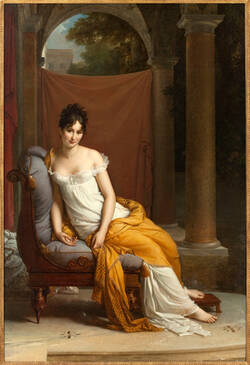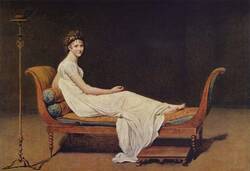Further Media
This miniature painting is a slightly altered copy after the well-known Portrait of Madame Récamier (1805) by the French painter François Gérard (1770-1837). The original painting, which is preserved today at the Musée Carnavalet in Paris, shows Juliette Récamier (1777-1849), who was praised for her extraordinary beauty and for many years organised a salon where the most important intellectuals of her time would gather regularly. She quickly became a leading personality on the European stage, repeatedly succeeding in setting trends and establishing tastes. Her name is virtually synonymous with the fashion and interior design of French Classicism, and in particular with a piece of furniture in which the French painter Jacques-Louis David depicted her in 1800: the récamière.
Madame Récamier also caused a sensation in Germany. Her relationship with Prince Augustus of Prussia (1779-1843) became legendary. He would ask her to marry him, but ultimately had to content himself with the portrait by Gérard, which took pride of place in his palace in Berlin’s Wilhelmstraße. The painter of the present miniature could have seen it there, although it is equally conceivable that he had access to one of the many copies that were made due to the fame of the painting and its sitter. The numerous differences in the colouring, for example in the shawl, curtain and seat cushion, suggest that a printed copy provided the source.
The most obvious difference, however, is the sitter herself. A pencil note on the reverse identifies her as Wilhelmine von Colloredo-Mannsfeld (1826-1898). Contemporary portraits of the countess confirm this identification. The reference to the portrait of Madame Récamier thus becomes even more interesting, for although she was still alive at the time the miniature was probably painted, her days as a courted hostess were long behind her. Her reputation, however, seems to have endured. Gérard’s portrait continued to be regarded as a reference for the depiction of a graceful lady entering into a symbiotic relationship with her surroundings – in this case a Renaissance-style loggia opening onto a garden.
Text: Alexander Röstel

